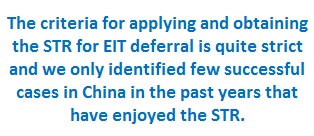Updates on Enterprise Income Tax Treatments for Restructuring
 Background
Background
In the spring of 2014, the Chinese State Council has published a circular (Circular 14), emphasizing the importance of Mergers and Acquisitions ("M&A") transactions in the economic development, and showing the directions to improve the efficiency, of said transactions, among other encouraging policies. Responding to said Circular 14, the Chinese Ministry of Finance and the State Administration of Taxation ("SAT") have jointly promulgated two new circulars, namely Circulars 109 and 116, which have lowered the criteria for enjoying certain beneficial tax treatments applicable to M&A transactions, enlarged the application scope of the said treatment and clarified other relevant tax treatment. In this article, we will outline the main contents of the new circulars and provide you with our observations.
Previous Rules under Chinese Enterprise Income Tax ("EIT") Law and Circular 59
According to the Chinese EIT Law, as a general principle, capital gains derived from M&A transactions have to be recognized based on the selling price of the involved target assets or equity (namely, said assets or equity's fair market value) minus the cost of the same. In such case, restructuring transactions taking place among group members of multinational companies ("MNC"s) could incur significant EIT liabilities overall to the MNCs, since any transfer of assets or equity could generate capital gains for EIT purposes.
The Chinese State Administration of Taxation ("SAT") observed this obstacle and Circular 59 was issued in 2009 to optimize EIT in restructurings in a prudent manner. This circular provided a Special Tax Regime ("STR") to said restructuring transactions, namely entitling the involved transaction parties to an EIT deferral for any capital gains derived therefrom, if the following conditions are met together:
The restructuring shall take place for reasonable commercial purposes, rather than to avoid, reduce or delay tax costs;
The ratio of the assets/equity to be acquired or merged shall meet the prescribed requirement, i.e. said assets/equity should account for 75% of the total asset/equity of the target entity to be acquired ("Acquisition Ratio");
The original business activities corresponding to the acquired assets or equity shall remain unchanged for, at least, 12 months after the M&A transaction;
Payment in equity (i.e. the "share consideration" compared to cash or other consideration) shall account for, at least, 85% of the total consideration involved in the M&A transaction; and
The main shareholder receiving the share consideration shall not transfer the said equity within 12 months as of the M&A deal.
 In addition to be above, non-resident enterprises involved in an M&A transaction in China has to meet additional requirements to enjoy the EIT deferral STR. To mention one of them, the non-resident enterprises have to have a 100% equity holding relation with either their overseas affiliates or their Chinese affiliates involved in the restructuring transaction; and, furthermore, the overseas transferor has to guarantee the relevant Chinese tax bureau in writing that it would not transfer the relevant equity obtained in the transaction in 3 years (inclusive).
In addition to be above, non-resident enterprises involved in an M&A transaction in China has to meet additional requirements to enjoy the EIT deferral STR. To mention one of them, the non-resident enterprises have to have a 100% equity holding relation with either their overseas affiliates or their Chinese affiliates involved in the restructuring transaction; and, furthermore, the overseas transferor has to guarantee the relevant Chinese tax bureau in writing that it would not transfer the relevant equity obtained in the transaction in 3 years (inclusive).
As shown, the criteria for applying and obtaining the STR for EIT deferral is quite strict and we only identified few successful cases in China in the past years that have enjoyed the STR. In addition, it is noteworthy that EIT deferral is a delay of the relevant tax payment liability, which does not represent an EIT exemption. Thus, in an eventual case, the EIT deferral might result in more EIT contribution in the future.
Due to the outlined reasons, it was a general demand of tax specialists in China that the Chinese STR applicable to corporate restructuring transactions would further be eased, allowing more transactions falling in the threshold of the tax deferral regime and, thus, further mitigating or avoiding additional transaction costs for companies aiming at restructuring their corporate functions, assets and risks based on market demands.
Said demand for a less tight STR on corporate restructurings might now have been heard, at least partially, under the new Circulars 109 and 116.
New Circular 109 & Circular 116
 Circular 109
Circular 109
Circular 109 has lowered the 75% Acquisition Ratio to 50% in a general manner, which indicates the other aforementioned conditions remain and keep on restricting the application of STR for EIT deferral.
In addition, Circular 109 has further established, as long as the aforementioned conditions 1) and 3) are met, a new preferential treatment ("NPT") to the assignment of equity/assets among qualified resident enterprises, i.e. (i) assignments taking place between parent resident enterprise and its 100% directly controlled resident subsidiaries and (ii) assignments taking place between resident enterprises under the same 100% direct control of one or more identical resident parent company(ies) might benefit from said NPT. Said NPT implies that (i) the assignor and assignee do not recognize capital gains, (ii) the tax basis of the assigned assets or equity for the assignee shall be assessed by the original net book value recognized by the assignor, and (iii) the deductible amortization of assigned assets for the assignee shall be assessed based on the original net book value recognized by the assignor.
Circular 116
Circular 116, in parallel, allows a 5-year-straight postponing on any capital gains generated by a resident enterprise from its equity investment in another resident enterprise, as long as said investment had been carried out in the form of an in-kind contribution of assets (equity in exchange for a non-cash contribution); consequently, the relevant EIT due by the equity contributor could be deferred in 5-year-straight installments.
 Garrigues' Observations
Garrigues' Observations
In general, Circular 109 and Circular 116 have come up with significant tax relief for M&A transactions in China, as more transactions would meet the requirements and thresholds to enjoy the EIT deferral under the STR, along with the NPT among resident enterprises. Nevertheless, we would like to draw your attention to the following salient points:
-From a wording perspective, the NPT under Circular 109 applies on M&A transactions among Chinese resident companies only; rather than to include non-Chinese resident companies. Non-Chinese resident companies may benefit from the original STR in their M&A transactions by virtue of the Acquisition Ratio being reduced.
Foreign investors might consider establishing a Chinese holding company ("CHC") to consolidate and manage all the Chinese subsidiaries. CHC is foreign investment vehicle in China with rather high criteria to incorporate, e.g. a CHC shall have at least 30 million USD registered capital to be newly injected by a foreign investor. Apart from ordinary foreign invested enterprise ("FIE"), a CHC can manage equity investments in China as its usual business to have various Chinese subsidiaries. Indeed, a CHC could be a representation of the foreign investor in China. CHC being the case, any potential restructurings of the subsidiaries beneath the CHC might be performed in the tier below/with CHC as pure domestic transactions for purpose of enjoying the NPT by satisfying the less strict conditions under Circular 109.
-As regards the NPT for resident enterprises, the wording of "assignment" has been introduced, which is not quite clear. It might be expected that Chinese authorities might issue implementation circulars to further explain the term of "assignment". Normally, a term of "assignment" in China usually appears in the transactions among stated-owned bodies, e.g. governmental bodies or state-owned enterprises ("SOE"), where relevant assets/equity might be only assigned without consideration on the basis of their internal system. If the term of "assignment" in Circular 109 shares same concept for the state - owned bodies, it would come up with a financial issue for the assignor or/and assignee on how to balance their accounts in such non-cash-flow transactions. Donation income or/and expenditure entries can be imagined but still need further clarification by Chinese authorities.
In light of the above, enterprises planning to perform restructurings in China would be recommended to pay attention to these updates and be well prepared in the relevant documentation. Furthermore, updates of the implementation rules of Circular 59 are expected to be published soon. Garrigues China is fully available to provide a more in-depth analysis on the application of both the new circulars and updated tax treatments.
---END---